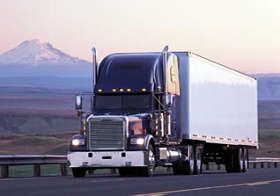Bridge Law Chart.. Rand Mcnalley
Topic 14115 | Page 2

That's the easiest way to figer it out, you just need to know all the axel space ings. Also rember you can not exceed the tire weight rating or the axel weight ratings. When bridging out.

I just figured it out and it jives with our mathematicians calculations earlier in the post...if the distance between the center of the front drive axel and the center of the rearmost tandem axel is 39 feet with that being a set of 4 axels then 68000 is allowed. Shorten that distance to say 34 feet then only 64500 is allowed. It's getting clear as mud. I wonder if the safety dude that blew me off will let me borrow a measuring tape.
Tandem:
Tandem Axles
A set of axles spaced close together, legally defined as more than 40 and less than 96 inches apart by the USDOT. Drivers tend to refer to the tandem axles on their trailer as just "tandems". You might hear a driver say, "I'm 400 pounds overweight on my tandems", referring to his trailer tandems, not his tractor tandems. Tractor tandems are generally just referred to as "drives" which is short for "drive axles".

Dont forget to figer the distense from the rear most drive axel to the stear axel. And total from stear to rear most trailer axel. If you just take the distense from the trailer to the drive then you can legally carry 68000 between there. Dose not tell you what you can carry over all or between the drives and the stear.

Thanks, yes I see that... The complexity of the calculations goes far to explain the blank stares and shrugged shoulders I've been getting when asking fellow drivers. Again, thanks. Your insight provided much more clarity than some perhaps more scholarly responses.
Yeah, say "What's a bridge formula?" to me and you get
blank stares and shrugged shoulders

Kingpin and bridge law are totally different animals just like you thought. I will come back and explain a little more on this tonight but I gotta leave now but one thing is that you are NOT going to be over on the bridge with what you are pulling unless you are over on a set of axles.

I'm kind of curious if anyone here has ever had a shipper reload a trailer for the kingpin law that's not going to/from California?
I just hauled a load through Illinois that was over their restriction. I've heard of people getting busted there on state routes but not interstate (and I've seen lots of guys in Chicago with tandems all the way back).
I've always rolled if I can get the axle weights legal (and not Cali), but I've heard those tickets are worse than overweight.
Shipper:
The customer who is shipping the freight. This is where the driver will pick up a load and then deliver it to the receiver or consignee.
Tandems:
Tandem Axles
A set of axles spaced close together, legally defined as more than 40 and less than 96 inches apart by the USDOT. Drivers tend to refer to the tandem axles on their trailer as just "tandems". You might hear a driver say, "I'm 400 pounds overweight on my tandems", referring to his trailer tandems, not his tractor tandems. Tractor tandems are generally just referred to as "drives" which is short for "drive axles".
Tandem:
Tandem Axles
A set of axles spaced close together, legally defined as more than 40 and less than 96 inches apart by the USDOT. Drivers tend to refer to the tandem axles on their trailer as just "tandems". You might hear a driver say, "I'm 400 pounds overweight on my tandems", referring to his trailer tandems, not his tractor tandems. Tractor tandems are generally just referred to as "drives" which is short for "drive axles".
Interstate:
Commercial trade, business, movement of goods or money, or transportation from one state to another, regulated by the Federal Department Of Transportation (DOT).
HOS:
Hours Of Service
HOS refers to the logbook hours of service regulations.
I feel confident I've got this figured out even to the point of being able to explain it. Throw the mathematical equation out. It's not necessary as the chart in the atlas makes it very simple. First realize the word/term bridge has two meanings here. The first, which probably most readily comes to mind, is a structural man made bridge, for instance, the Golden Gate. The law was inacted to protect these man made structures from damage potentially caused by excessive concentrated weight. The amount of concentrated force exerted to the man made structural bridge as you drive across it varies with the span of distance between you axels. Axels close together equals lots of concentrated weight, axels spread apart equals lesser concentrated weight and therefore less potential for damage to the man made structural bridge below. The second meaning of the word "bridge" applies to the truck. The standard semi-truck has 3 bridges, two internal and one external. The "truck" bridge is defined as the span between any two sets of consecutive axels. As suggested, a standard semi has 3 bridges. The external bridge is from the centerline of the steer axel to the centerline of the rear most trailer tandem. The two inner bridges are A)from the centerline of the steer to the centerline of the rear drives and B) from the centerline of the front drives to the centerline of the rear most tandem. So, to " bridge out " your truck you need to know the distances between these three separate "truck bridges". Let's say the distance of inner bridge A) (the centerline of the steers to the centerline of the rear drives) is 16 feet. You enter the atlas chart and go down to 16 feet then across to "three axels" because that's the number of axels within this bridge ( the steers, the front drives and the rear drives). With this distance and number of axels we see that 48000 pounds is allowed on this one of three "truck bridges". You would look at your CAT scale ticket and add together your steer weight and your drive weight and need to be less than 48k to be legal. The next bridge to check is inner bridge "B", the distance between the centerline of the front drives and the centerline of the rear most tandem. Let's say that distance is 40 feet. Enter the chart at 40 feet, go over to "4" axels because that's what's in this bridge ( front drive, rear drive, front trailer tandem , rear trailer tandem) and we see that in this case 68500 is allowed. You would look at your CAT scale ticket, add together the weights of the drives and the weights of the trailer tandems , and need to be less than 68500 to be legal. Obviously since our max on these axes is 34k each for a total of 68k, we better be good. The last "truck bridge" to check is the external bridge... The long one between the centerline of the front steers and the centerline of the rear most tandem. Let's say this distance is 51 feet. We enter the chart at 51 feet, go over to "5 axels" because that's what's in this bridge ( the steers, front drive, rear drive, front trailer tandem, rear trailer tandem) and see that at this external truck bridge length we are good for 80,000 lbs. So in other words, to have your truck at gross weight, 80k, the distance between the steers and the rear most tandem must be at least 51feet. Have I gotten out of the truck with a measuring tape yet? No. But I now feel like if a DOT officer ever engages me about the bridge law I won't simply offer him/her a blank stare.
Tandems:
Tandem Axles
A set of axles spaced close together, legally defined as more than 40 and less than 96 inches apart by the USDOT. Drivers tend to refer to the tandem axles on their trailer as just "tandems". You might hear a driver say, "I'm 400 pounds overweight on my tandems", referring to his trailer tandems, not his tractor tandems. Tractor tandems are generally just referred to as "drives" which is short for "drive axles".
Tandem:
Tandem Axles
A set of axles spaced close together, legally defined as more than 40 and less than 96 inches apart by the USDOT. Drivers tend to refer to the tandem axles on their trailer as just "tandems". You might hear a driver say, "I'm 400 pounds overweight on my tandems", referring to his trailer tandems, not his tractor tandems. Tractor tandems are generally just referred to as "drives" which is short for "drive axles".
DOT:
Department Of Transportation
A department of the federal executive branch responsible for the national highways and for railroad and airline safety. It also manages Amtrak, the national railroad system, and the Coast Guard.
State and Federal DOT Officers are responsible for commercial vehicle enforcement. "The truck police" you could call them.
CAT Scale:
A network of over 1,500 certified truck scales across the U.S. and Canada found primarily at truck stops. CAT scales are by far the most trustworthy scales out there.
In fact, CAT Scale offers an unconditional Guarantee:
“If you get an overweight fine from the state after our scale showed your legal, we will immediately check our scale. If our scale is wrong, we will reimburse you for the fine. If our scale is correct, a representative of CAT Scale Company will appear in court with the driver as a witness”

Wow.
New Reply:
New! Check out our help videos for a better understanding of our forum features

















Preview:
This topic has the following tags:
Bridge Heights DOT Truck Equipment Understanding The Laws Weight and Scales







 TT On Facebook
TT On Facebook
I think Rand Mcnalley has tried to make it easy with the handy chart/graph in the front of the atlas. I'll figure it out eventually.